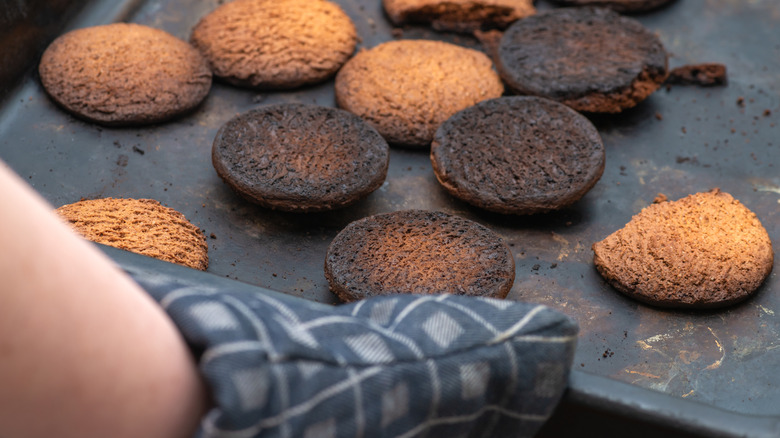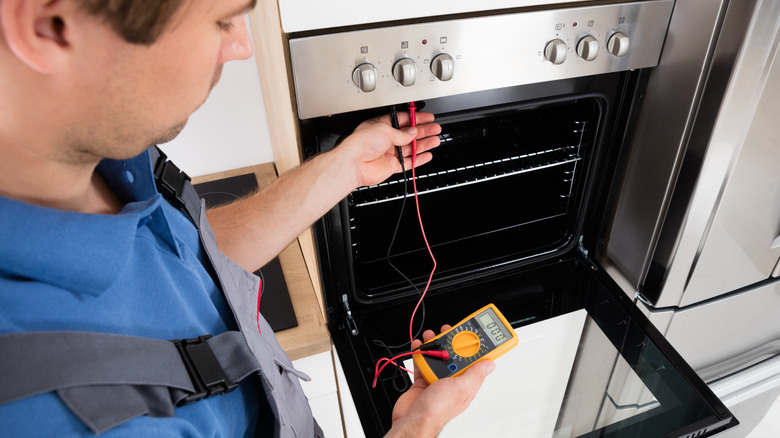Why Periodically Checking Your Oven's Temperature Is Absolutely Essential
We may receive a commission on purchases made from links.
Trusting your oven's temperature is a gamble. Just because you set it to 350 degrees Fahrenheit doesn't mean that the temperature inside the oven is 350 degrees. America's Test Kitchen found that many home ovens can be off by as much as 50 degrees. Even a 25-degree swing, in either direction, will have a huge impact on the results, especially when baking. They tested popovers at three separate 25-degree intervals. The lower temp meant a lower rise. The highest temp was misshapen and overly browned. The proper temp was, you guessed it, just right.
Getting to know your oven is more than just knowing where the hot and cold spots exist. Those idiosyncrasies can be overcome by staggering baking pans, and rotating your baked goods while cooking. This is a good idea, even if your oven is accurate, per Cook's Illustrated.
There's only one way to trust your oven's temperature setting. You're going to need an oven thermometer.
The best way to check your oven's temperature
Oven thermometers are inexpensive tools but they aren't created equally. America's Test Kitchen says it dislikes alcohol-based bulb thermometers for being inaccurate over time and hard to read. Preferred oven thermometers have large, dial faces that are controlled with a bimetallic coil. That strip of two metals expands and contracts with the temperature. Plus, these usually have a broad base to give them sturdy footing on an oven rack. Its favorite, the CDN DOT2 ProAccurate Oven Thermometer is less than ten bucks at Amazon.
Once you have a thermometer, the best way to test your oven is to set a rack in the center. Set the thermometer in the center of that rack and turn your oven on to 350 degrees. Once the oven has indicated it's preheated, check the oven thermometer. If it's off, don't despair quite yet. East Coast Appliance explains that the time to preheat the oven varies between 10 and 20 minutes. So, despite the indicator that it's preheated, give your oven a full 20 minutes. It's a good idea to take a few readings over the course of an hour because ovens cycle on and off within a range. So, average those readings. At that point, any difference between the oven's setting and the thermometer is likely accurate.
What to do if your oven's temperature is off
If your oven is accurate, safely remove the thermometer and bake with confidence. There's no need to leave the thermometer in the oven at all times. It takes up space and will become tough to read as it gets dirty. It's a good idea to re-test your oven every six months.
If the setting and thermometer readings don't jive, there are steps you can take to not compromise your baking. The simplest solution is to adjust the temperature you set on the oven. If your oven temperature is only 335 degrees when it should be 350, try setting the oven to 365 degrees. Of course, perform a second test with the oven thermometer to confirm that this change is accurate.
If your oven is off by more than 40 degrees, further investigation is needed. The first thing to check, according to CNET, is that the temperature sensor inside the oven isn't touching the oven wall. This can happen when you give your oven a spring cleaning. That misplacement will confuse the oven's thermostat. In many cases, the sensor can be carefully moved away from the wall.
Beyond that, refer to your oven's manual for calibration steps. The Repair Clinic explains five other maladies that can make your oven inaccurate. In many cases, the calibration, or repairs, will have to be done by a service person.


